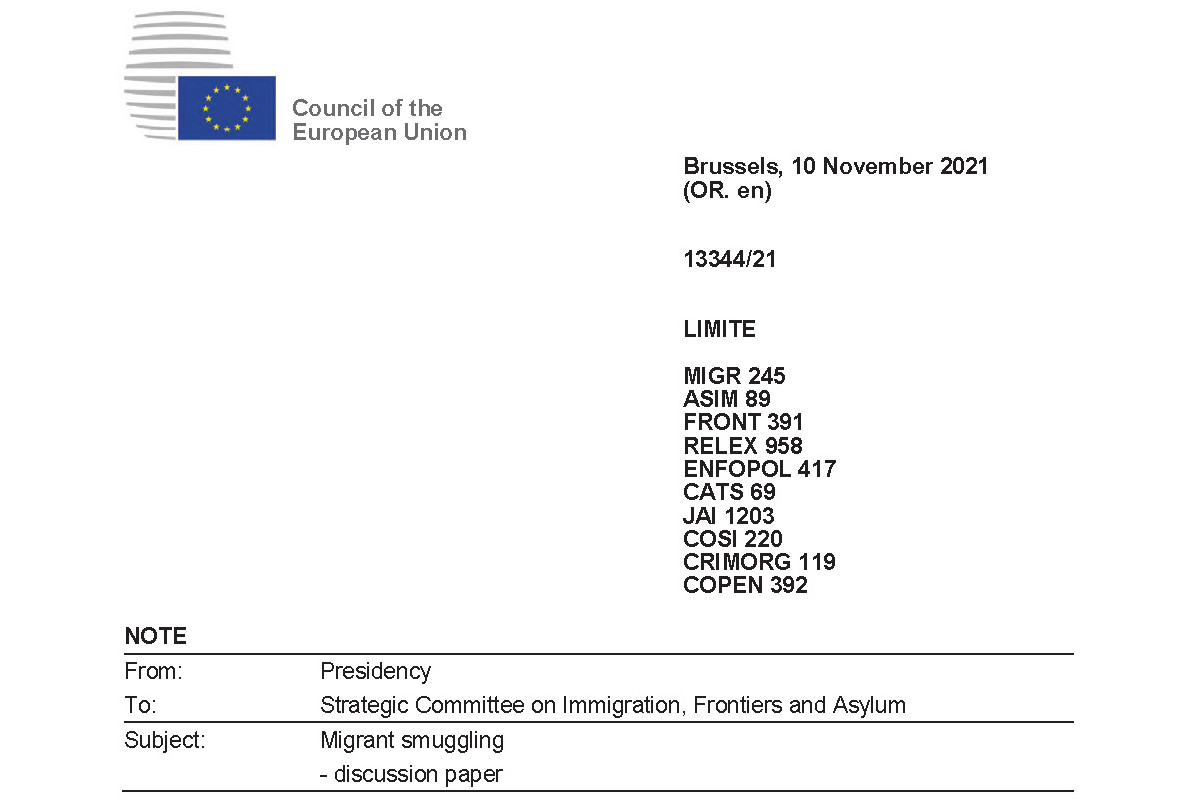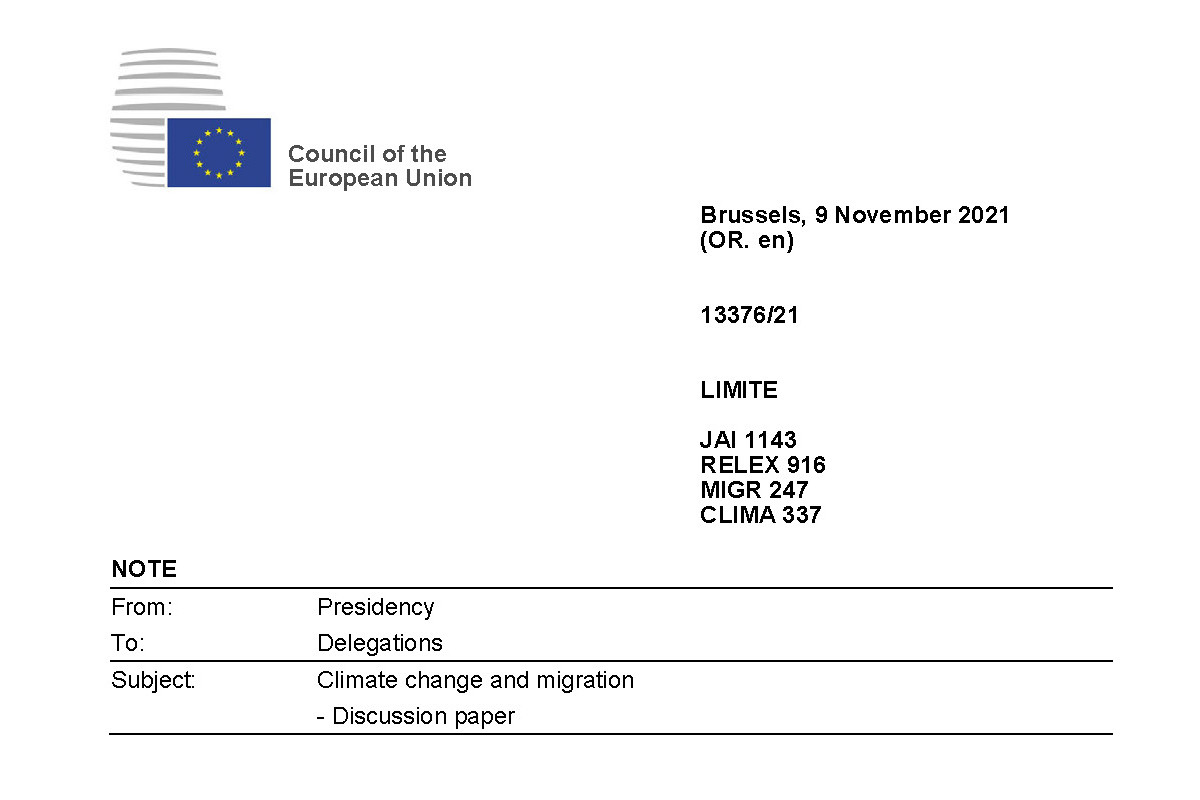EU: Tracking the Pact: Council ponders new action on migrant smuggling and "secondary movements"
Topic
Country/Region
11 November 2021
In reponse to the publication of the EU's new action plan on migrant smuggling and the ongoing discussions on the new Pact on Migration and Asylum, the Council has begun discussing new ways to deal with migrant smuggling and "secondary movements," defined as "the journeys undertaken by third-country nationals and stateless persons from one EU/[Schengen state] to another without the prior consent of national authorities and with or without facilitation."
Support our work: become a Friend of Statewatch from as little as £1/€1 per month.

NOTE from: Presidency to: Strategic Committee on Immigration, Frontiers and Asylum: Secondary movements - discussion paper (Council doc. 13343/21, LIMITE, 9 November 2021, pdf)
"When analysing the phenomenon, we encounter some very basic dilemmas and challenges. The first is the common understanding of the notion of secondary movement, as it involves third country nationals who have varying statuses and are in diverse situations.
(...)
The second challenge, partially linked to the first one, is the lack of sufficient data and information to determine the scale of secondary movements within the EU, including the trends, details of migrant profiles, drivers, modus operandi and potential facilitators involved in these movements."
The note foresees the implementation of the 'interoperability' plans and the expansion of numerous existing databases as providing a way to improve "situational awareness," in particular with changes to the Eurodac database that will allow the gathering of data on irregular migrants as well as asylum-seekers.
The Presidency asks delegations in the Strategic Committee on Immigration, Frontiers and Asylum (SCIFA):
"1) What is your assessment of the progress achieved in scoping secondary movements over recent years? Do the current tools, collecting and reporting of figures provide a sufficient level of knowledge/awareness of the phenomenon?
2) In your opinion, what are the key challenges related to addressing secondary movements? To which next steps should priority be given?
3) Should a link be drawn between secondary movements and the fair sharing of solidarity?"
NOTE from: Presidency to: Strategic Committee on Immigration, Frontiers and Asylum: Migrant smuggling - discussion paper (Council doc. 13344/21, LIMITE, 10 November 2021, pdf)
The document explains the offence of migrant smuggling and the ways in which smuggling takes place and is facilitated. It also notes:
"Irregular migrants are exposed to high fees for services that increasingly violate their physical and psychological integrity during the journey. In addition, they are vulnerable to further exploitation upon arrival. In some cases, they could even be forced by smugglers to facilitate smuggling operations (e.g. driving a boat), which can have legal consequences for the applicant concerned."
Indeed, this is precisely the situation in Italy, the UK and Greece - where the authorities have actively chosen to prosecute people for driving boats. In one ongoing case in Greece for which a new campaign was launched this week, a man is facing life imprisonment for that act.
The Presidency's note goes on to explain action taken since the publication of the first EU action plan on migrant smuggling in 2015, which was recently followed by a new plan (COM(2021) 591 final, pdf) that places overwhelming emphasis on repressive measures that are only likely to spur the use of more dangerous routes.
The Presidency considers that cooperation with non-EU states is crucial if the "phenomenon" of smuggling is to be dealt with:
"EU and its Member States must continue to address the key drivers for illegal migration used by smugglers in close cooperation with partner countries of origin and transit in a spirit of partnership and mutual responsibility. In addition, the narrative used by smugglers needs to be addressed and changed."
Cooperation with third states:
"...will aim at strengthening legal, policy, operational and strategic frameworks in partner countries based on their respective needs and increasing the impact, ownership and sustainability of efforts to tackle migrant smuggling. These actions will build on the United Nations (UN) Protocol against the Smuggling of Migrants by Land, Sea and Air, supplementing the UN Convention against Transnational Organized Crime. Synergies and consistency with other relevant policies and actions will be promoted and ensured, including in the field of security (e.g. border security, fight against organised crime), development cooperation (e.g. education and training, community development, sustainable and inclusive economic development) and good governance (e.g. fight against corruption)."
The first targets are states in the Western Balkans, Eastern Mediterranean, as part of "a whole of route approach that includes the Silk Road countries as well as countries in North and West Africa."
Amongst other things, the document also notes that preventing the falsification and alteration of identity documents is key:
"...from May 2022, all visa stickers will be issued with a QR code including the data printed on the visa as an additional security feature; since August 2021 EU citizens have been receiving new ID cards with harmonised and enhanced security features. However, the Member States remain responsible for documents such as birth, marriage and death certificates that are used to support applications for identity and travel documents. The same applies to other supporting documents used to justify applications for a visa or residence permit. The security of these 'breeder documents' is a key factor in enhancing internal security and fighting organised crime, including migrant smuggling. More focus should also be placed on breeder documents issued by third countries to improve their security." [emphasis added]
The Presidency ends by asking delegations three questions:
"1. Do you consider the proposed actions in the renewed EU action plan against migrant smuggling (2021-2025) and other proposals sufficient to address the identified shortcomings in the EU legal and operational framework? Which actions should the EU and its Member States take as a priority?
2. In particular, when developing anti-smuggling operational partnerships, which partners should the EU and the Member States turn to in the short to medium term and what should be the building blocks of such partnerships?
3. How can the issue of the abuse of the asylum system for the purpose of migrant smuggling be addressed?"
Our work is only possible with your support.
Become a Friend of Statewatch from as little as £1/€1 per month.
Spotted an error? If you've spotted a problem with this page, just click once to let us know.

